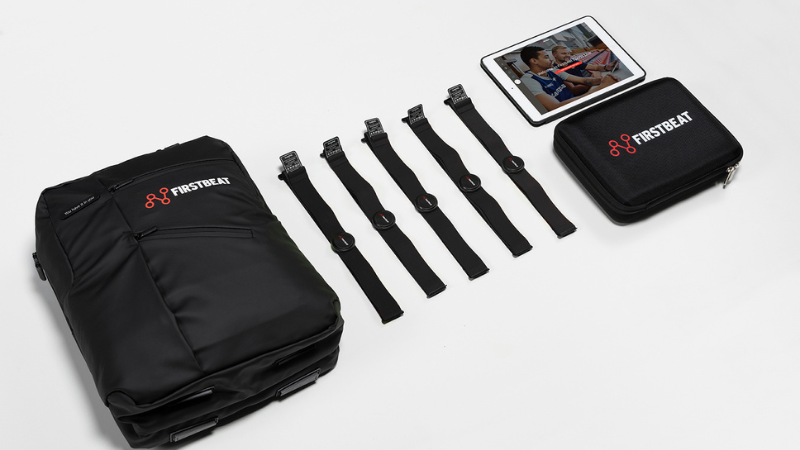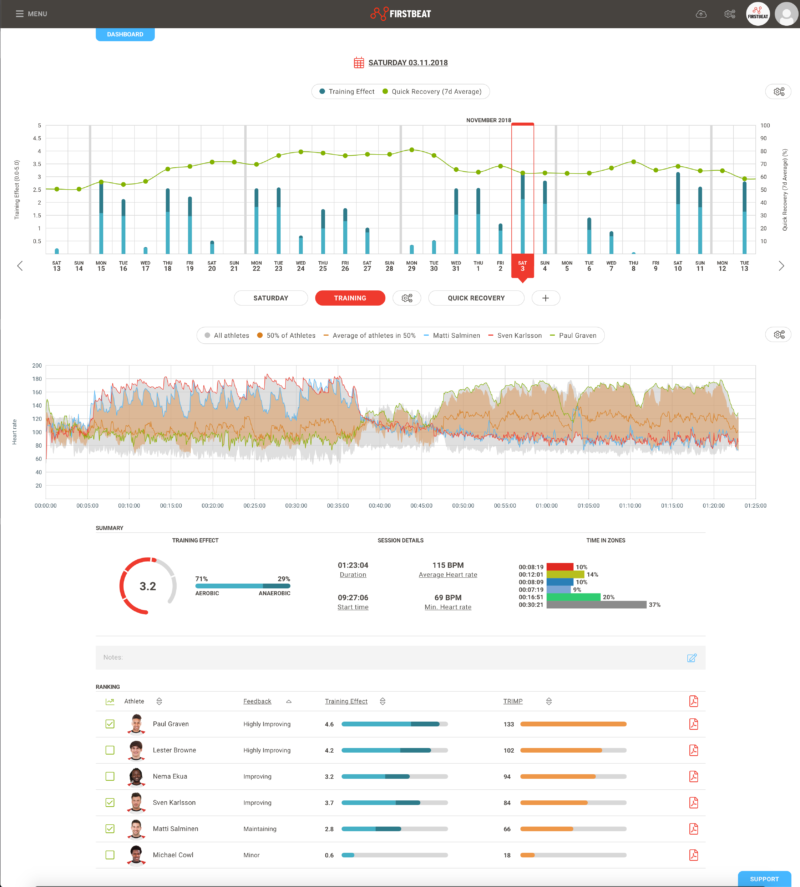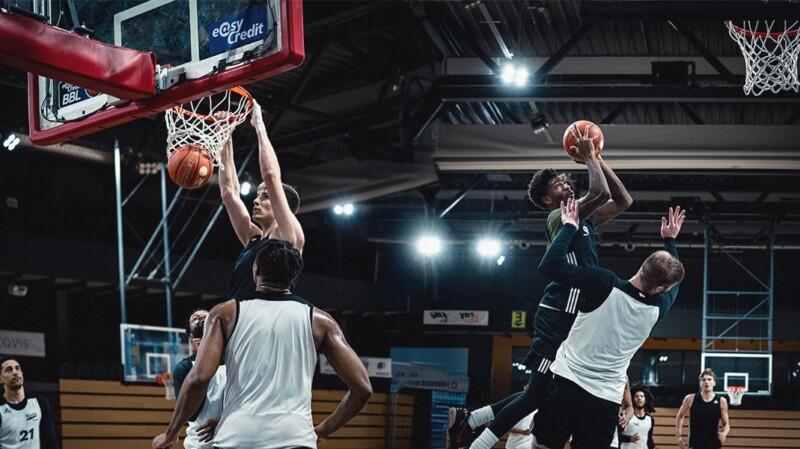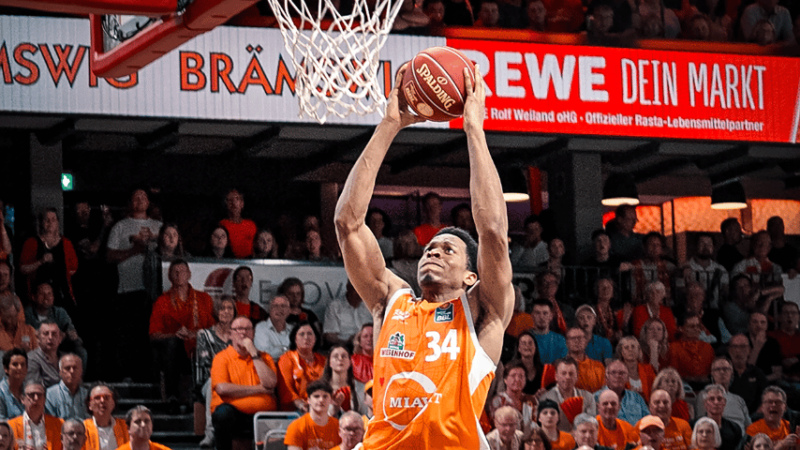
RASTA Vechta is a basketball team currently playing in the Pro A, the second division of professional basketball in Germany. We recently spoke with Vechta’s Performance Coach, Domenik Theodorou, to learn more about Firstbeat Sports’ role in decision-making in coaching, live monitoring, load management, and athlete buy-in.
Basketball is Everything in Vechta
Despite being a small city of no more than 33,000 inhabitants, the city of Vechta is well known for its love for the game. “Everyone here knows RASTA Vechta. Our arena, the RASTA Dome holds up to 3,140 fans and tickets sell out quickly. In the end, you can say that approximately 10% of the people who live here come to our games and they are extremely loud,” explains Domenik.
The enthusiasm from Vechta fans was something that Domenik was well aware of when he decided to join RASTA Vechta as a Performance Coach in 2022. He had experienced Vechta’s avid fans many times before whilst working for his former teams Brose Bamberg and BG Göttingen. “Whenever we played in Vechta, I would always be amazed by how loud the RASTA Dome could get. It’s a special place – even as an opponent.”
Climbing Back Up The Ranks
Before Domenik joined the team in 2022, it’s fair to say that Vechta went through a rough time moving down from the Basketball Bundesliga (BBL), Germany’s highest level, to the Pro A. Nevertheless, Domenik believed in the team’s potential, thanks to its unique infrastructure: “The arena is available for us 24/7. This is rather rare in German basketball. We also have our practice gym including a weight room right next to the arena. Simply put, it’s a superb setup to build a team and develop players. All the coaches are passionate about what we do– getting them out of the practice gym is tough! They are about improving players and improving as a team and organization. It’s such a family atmosphere and there’s so much heart, and the coaching staff here works together to make decisions.”
With almost half the season underway, things are starting to fall into place for the team as they continue moving up the ranks. Domenik says:
“I think we are on a good track, but I like to keep a clear focus. It’s still a long way and a lot of things can happen. Injury-wise, right now I think we’re doing ok but that can change within a second, so that’s why I’m just happy where we are right now. I hope we can manage to stay healthy and keep improving as a team because I think we still have a lot of room left to improve. It’s a long season, and in the end, it’s the playoffs that will be decisive if we manage to go up or not, but we obviously will try to do everything to achieve that.”
Getting Started with Firstbeat

Although Domenik has only been using the Firstbeat Sports system since 2021, he has already integrated it into practices to a point where he thinks it is genuinely helpful in decision-making.
Domenik first started using the Firstbeat system with his former team and dedicated some initial time to studying how to get the best out of it. “I think I locked myself in my office for four days, because if I want to do something I want to do it 100%,” he says. “I wanted to be as best prepared as possible when I started using it with the team. To be fair, initially, I didn’t use Firstbeat to the extent I’m using it right now.
This season, I’m looking at a wider range of numbers, I’m looking at the different parameters, and I’m always asking myself ‘where can I use it, how can I use it even better without over analyzing?’ The way I integrate Firstbeat with our team is based on a mix of common sense and a lot of trial and error. For me, Firstbeat adds a valuable layer of information to our training, and it helps in fine-tuning our decision-making for live monitoring, load management, and rehab processes.”
A Lean System

Firstbeat Sports Dashboard
Unlike other systems, Domenik describes Firstbeat as user-friendly and easy to understand.
“When I spoke to colleagues who were implementing other live-monitoring tools, a lot of times they would refer to them as complicated and time-consuming. I always like to call Firstbeat a very lean system that doesn’t swamp you with parameters that you basically don’t use. The cloud function makes it accessible from anywhere and the dashboard design is very clear and flexible. You can choose your key metrics and customize the online view to your personal needs. On top of that, Firstbeat is incredibly stable, there are barely any disruptions. It simply works.
Another feature that we use is the online option of assigning different coaches to our team. For example, our sports director might not be present at every team practice, but with Firstbeat he can still get all the reports and can oversee everything that is going on. Just by looking at the report he gets a very good feeling for the intensity of each practice session.”
Athlete Buy-In
As to be expected, there were some initial grumbles from some players in the beginning who weren’t too happy to wear the sensors, but the Firstbeat system has very quickly become part of the pro team’s training culture.
“The players wear it all the time, that’s how we operate over here. Our pros wear it on a mandatory basis during every team practice, team shooting, or individual workouts.
For every session, the heartbeat straps will be set up and ready to use on a laundry rack. The suitcase with the little sensors will be right next to it. By now, everyone sets it up by themselves and leaves it ready to dry after work.”
For those athletes that are really interested, Firstbeat allows a deeper understanding of their performance. Pro player Ryan Schwieger played basketball in the US at Princeton University and Loyola University in Chicago before joining the Vechta team in 2022. He says:
“The Firstbeat data really helps me understand how to optimize my performance. Especially coming back from an injury, it allows me to really see where I’m at and the progress I’m making to return to the court.”
Using Firstbeat in Daily Practice and Rehabilitation
On a day-to-day basis, the way Domenik makes use of Firstbeat is very diverse. He says: “I use it for live monitoring, load management, for daily and weekly analysis, but also for weekly ratios. During team practice, I always have a little paper in front of me with average practice loads for each player for different practice days.
“In an ideal world, we would always have 4-days preparation. If we play on a Saturday, Tuesday would be matchday -4, Wednesday would be matchday -3, and if we have different goals for each day then I can always check the average load of the players for these days. Besides that, I also keep track of the highest/lowest TRIMP and Movement Load for each player. My key parameters are TRIMP, Movement Load, and EPOC-peak.
We also use Firstbeat for rehab and return-to-activity scenarios. When a player is ready for on-court work again, we would gradually (day by day) increase his workload until he reaches the demands of previous team practices. Provided that a player doesn’t experience any setbacks during this process, it’s a good reference for us that he is getting closer to resuming contact practice. Using Firstbeat in this way, we can carefully manage the rehab process by setting up different stages the player needs to pass before he joins the team to practice again.”
The Importance of Internal Load Monitoring
Since Domenik started using Firstbeat to monitor internal load, the system has given him opportunities to communicate better with his athletes, as well as track the players’ development and fitness.
“Last week I had a very interesting situation with one of our players. I noticed during team practice that his TRIMP was significantly higher (120) compared to his average TRIMP scores (78) one day before game-day. Interestingly, his Movement Load was within his usual range. I went to him, and just asked him ‘how was practice today?’, and he told me, ‘It was tough today, I didn’t really sleep well, I was in a little bit of a hurry because I left late for practice, and I’m a little stressed in general.’
And then I told him that I was able to identify a difference in his Firstbeat data compared to his former workloads for this particular practice day. He was very surprised that I could tell him that just by looking at the data. I believe this is a win-win-situation because I noticed something during live monitoring and it creates buy-in from the player towards Firstbeat.
Having this inside knowledge creates conversations and helps with building rapport with the guys. If I hadn’t used Firstbeat, I wouldn’t have known, because he seemed fine just by looking at him.”
Interested in learning more about the Firstbeat Sports solution? Contact us for more information
You might also be interested in

Mind The Gap: Internal Training Load During Practice vs. Competition
This article is written by Domenik Theodorou, a Firstbeat Sports client and Performance Coach at RASTA Vechta, a professional basketball team competing in the Basketball Bundesliga (BBL). Prior to his…

Optimizing Real-Time Athlete Monitoring Through Historical Data Analysis
This article is written by Domenik Theodorou, a Firstbeat Sports client and Performance Coach at RASTA Vechta, a professional basketball team competing in the Basketball Bundesliga (BBL). Prior to his…
